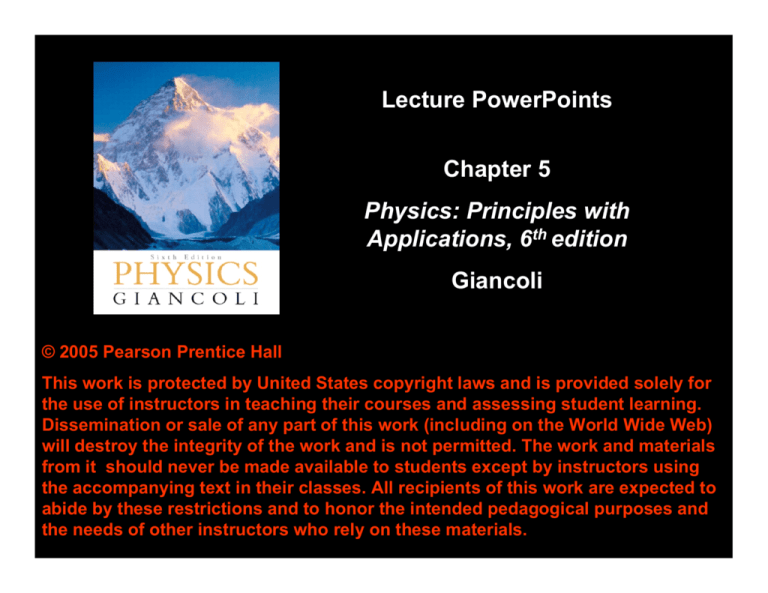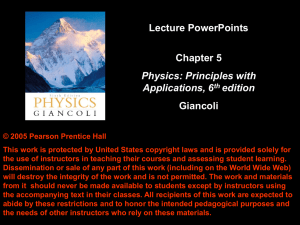
Lecture PowerPoints
Chapter 5
Physics: Principles with
Applications, 6th edition
Giancoli
© 2005 Pearson Prentice Hall
This work is protected by United States copyright laws and is provided solely for
the use of instructors in teaching their courses and assessing student learning.
Dissemination or sale of any part of this work (including on the World Wide Web)
will destroy the integrity of the work and is not permitted. The work and materials
from it should never be made available to students except by instructors using
the accompanying text in their classes. All recipients of this work are expected to
abide by these restrictions and to honor the intended pedagogical purposes and
the needs of other instructors who rely on these materials.
Chapter 5
Circular Motion; Gravitation
Units of Chapter 5
•Kinematics of Uniform Circular Motion
•Dynamics of Uniform Circular Motion
•Highway Curves, Banked and Unbanked
•Nonuniform Circular Motion
•Centrifugation
•Newton’s Law of Universal Gravitation
Units of Chapter 5
•Gravity Near the Earth’s Surface; Geophysical
Applications
•Satellites and “Weightlessness”
•Kepler’s Laws and Newton’s Synthesis
•Types of Forces in Nature
5-1 Kinematics of Uniform Circular Motion
Uniform circular motion: motion in a circle of
constant radius at constant speed
Instantaneous velocity is always tangent to
circle.
5-1 Kinematics of Uniform Circular Motion
Looking at the change in velocity in the limit that
the time interval becomes infinitesimally small,
we see that
(5-1)
5-1 Kinematics of Uniform Circular Motion
This acceleration is called the centripetal, or
radial, acceleration, and it points towards the
center of the circle.
5-2 Dynamics of Uniform Circular Motion
For an object to be in uniform circular motion,
there must be a net force acting on it.
We already know the
acceleration, so can
immediately write the
force:
(5-1)
5-2 Dynamics of Uniform Circular Motion
We can see that the force must be inward by
thinking about a ball on a string:
5-2 Dynamics of Uniform Circular Motion
There is no centrifugal force pointing outward;
what happens is that the natural tendency of the
object to move in a straight line must be
overcome.
If the centripetal force vanishes, the object flies
off tangent to the circle.
5-3 Highway Curves, Banked and Unbanked
When a car goes around a curve, there must be
a net force towards the center of the circle of
which the curve is an arc. If the road is flat, that
force is supplied by friction.
5-3 Highway Curves, Banked and Unbanked
If the frictional force is
insufficient, the car will
tend to move more
nearly in a straight line,
as the skid marks show.
5-3 Highway Curves, Banked and Unbanked
As long as the tires do not slip, the friction is
static. If the tires do start to slip, the friction is
kinetic, which is bad in two ways:
1. The kinetic frictional force is smaller than the
static.
2. The static frictional force can point towards
the center of the circle, but the kinetic frictional
force opposes the direction of motion, making
it very difficult to regain control of the car and
continue around the curve.
5-3 Highway Curves, Banked and Unbanked
Banking the curve can help keep
cars from skidding. In fact, for
every banked curve, there is one
speed where the entire centripetal
force is supplied by the
horizontal component of
the normal force, and no
friction is required. This
occurs when:
5-4 Nonuniform Circular Motion
If an object is moving in a circular
path but at varying speeds, it
must have a tangential
component to its acceleration as
well as the radial one.
5-4 Nonuniform Circular Motion
This concept can be used for an object moving
along any curved path, as a small segment of the
path will be approximately circular.
5-5 Centrifugation
A centrifuge works by
spinning very fast. This
means there must be a
very large centripetal
force. The object at A
would go in a straight
line but for this force; as
it is, it winds up at B.
5-6 Newton’s Law of Universal Gravitation
If the force of gravity is being exerted on
objects on Earth, what is the origin of that
force?
Newton’s realization was
that the force must come
from the Earth.
He further realized that
this force must be what
keeps the Moon in its
orbit.
5-6 Newton’s Law of Universal Gravitation
The gravitational force on you is one-half of a
Third Law pair: the Earth exerts a downward force
on you, and you exert an upward force on the
Earth.
When there is such a disparity in masses, the
reaction force is undetectable, but for bodies
more equal in mass it can be significant.
5-6 Newton’s Law of Universal Gravitation
Therefore, the gravitational force must be
proportional to both masses.
By observing planetary orbits, Newton also
concluded that the gravitational force must decrease
as the inverse of the square of the distance between
the masses.
In its final form, the Law of Universal Gravitation
reads:
(5-4)
where
5-6 Newton’s Law of Universal Gravitation
The magnitude of the
gravitational constant G
can be measured in the
laboratory.
This is the Cavendish
experiment.
5-7 Gravity Near the Earth’s Surface;
Geophysical Applications
Now we can relate the gravitational constant to the
local acceleration of gravity. We know that, on the
surface of the Earth:
Solving for g gives:
(5-5)
Now, knowing g and the radius of the Earth, the
mass of the Earth can be calculated:
5-7 Gravity Near the Earth’s Surface;
Geophysical Applications
The acceleration due to
gravity varies over the
Earth’s surface due to
altitude, local geology,
and the shape of the
Earth, which is not quite
spherical.
5-8 Satellites and “Weightlessness”
Satellites are routinely put into orbit around the
Earth. The tangential speed must be high
enough so that the satellite does not return to
Earth, but not so high that it escapes Earth’s
gravity altogether.
5-8 Satellites and “Weightlessness”
The satellite is kept in orbit by its speed – it is
continually falling, but the Earth curves from
underneath it.
5-8 Satellites and “Weightlessness”
Objects in orbit are said to experience
weightlessness. They do have a gravitational
force acting on them, though!
The satellite and all its contents are in free fall, so
there is no normal force. This is what leads to the
experience of weightlessness.
5-8 Satellites and “Weightlessness”
More properly, this effect is called apparent
weightlessness, because the gravitational force
still exists. It can be experienced on Earth as
well, but only briefly:
5-9 Kepler’s Laws and Newton's Synthesis
Kepler’s laws describe planetary motion.
1. The orbit of each planet is an ellipse, with
the Sun at one focus.
5-9 Kepler’s Laws and Newton's Synthesis
2. An imaginary line drawn from each planet to
the Sun sweeps out equal areas in equal times.
5-9 Kepler’s Laws and Newton's Synthesis
The ratio of the square of a planet’s orbital
period is proportional to the cube of its mean
distance from the Sun.
5-9 Kepler’s Laws and Newton's Synthesis
Kepler’s laws can be derived from Newton’s
laws. Irregularities in planetary motion led to
the discovery of Neptune, and irregularities in
stellar motion have led to the discovery of
many planets outside our Solar System.
5-10 Types of Forces in Nature
Modern physics now recognizes four
fundamental forces:
1. Gravity
2. Electromagnetism
3. Weak nuclear force (responsible for some
types of radioactive decay)
4. Strong nuclear force (binds protons and
neutrons together in the nucleus)
5-10 Types of Forces in Nature
So, what about friction, the normal force,
tension, and so on?
Except for gravity, the forces we experience
every day are due to electromagnetic forces
acting at the atomic level.
Summary of Chapter 5
• An object moving in a circle at constant speed is
in uniform circular motion.
• It has a centripetal acceleration
• There is a centripetal force given by
•The centripetal force may be provided by friction,
gravity, tension, the normal force, or others.
Summary of Chapter 5
• Newton’s law of universal gravitation:
•Satellites are able to stay in Earth orbit because
of their large tangential speed.










